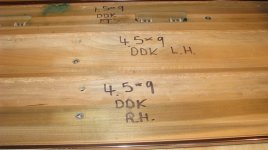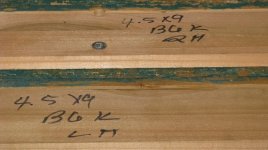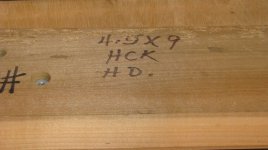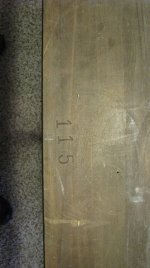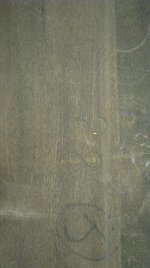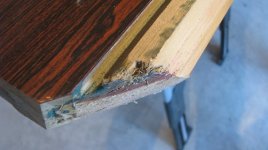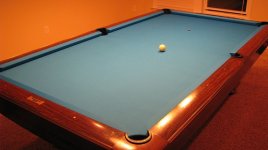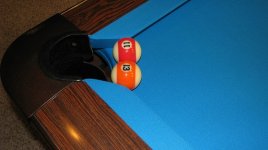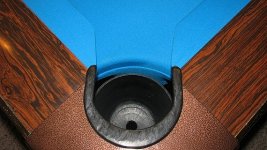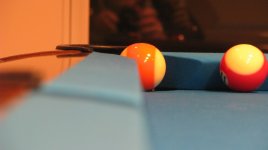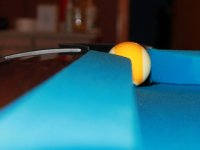ANY used table should be thoroughly inspected before you buy... EVEN DIAMOND TABLES!!!
On a GC-IV the issue is that the long frame supports stop short of the end supports.
Brunswick has had an ongoing problem with their frame designs from each GC version and changed their design once again with the GC-V, so that the long supports now run the full length of the frame to avoid the sagging slate issue. Brunswick always like to wait until the next generation of a GC to address frame issues and looks the other way when asked about the problems.
Hell... the best sales/mechanic in my area didn't even know that the GC-V had an altered frame design from the GC-IV or that there was a sagging problem (or so he implied). I felt obligated to educate him on the subject.
Rule #1... shoot slow, lingering shots along each rail (about 1" or 2" away from the cushion) on the table that you're wanting to buy and watch the tracking (especially around the corners). Crawl up under the table and look at the dowel joints where the upper frame wood connects (looking for gaps and separations). If you can see ANY part of the dowels then there is a problem. Also inspect for missing parts or any signs of abuse.
Video record the entire table (top to bottom and underneath) and carefully review the videos at home before signing anything!!! You'll be surprised what obvious flaws you can miss on the first inspection but will catch during a slow motion review at home.
Rule #2... if you know that the table is true, don't allow just any "yah-hoo" to quick set your table. They can be reckless and knock the dowel joints of the frame out of line (or do other damage) on an otherwise very good table. Once it's covered it has to be dismantled to fix and the "yah-hoo" isn't going to be the one qualified enough to fix it.
Rule #3... make sure that whoever sets up the table uses a rubber, leather or wood mallet, tapping at all of the framing joints and visually inspects them before laying the slate down on the frame. Also a good table mechanic will place a machinist level (usually a Starrett) at the frame joints to test the horizontal evenness of the framing connections for accuracy before the slate gets placed. It only takes an extra minute or two to do these things.
I'm not suggesting to bother or instruct the mechanic during his job... but it's your $$$ and a good mechanic doesn't mind being watched and it's your right to look over the work (OUT OF HIS WAY) as the table is being assembled. Just remember... a quality mechanic needs to stay focused as not to overlook things that aren't visually obvious.
In the case of the GC-IV it's an easy "permanent" fix with 16" of angle iron at each corner to correct the sagging issue for good (not sure about a fix on the earlier models). But don't expect your mechanic to carry angle iron on his truck!!! This should be discussed before delivery.
Also... any "installer" that spends less than 4 hours setting up a GC is not (in my opinion) a "billiard table mechanic" and has likely wasted your time and money (and probably screwed something up along the way).
I do like the flat rails of a Diamond compared to the arched rails on a GC. However I love my GC and find that I have more runs, and shoot better on GC's and Medalist (that are true) than on Diamonds. (not sure why).
I do wish that installer/mechanics would instruct on how to condition a Simonis (and other) cloths when they setup a table (there is a proper break-in of the cloth that should be followed). But that is another thread entirely.
And as for Glen... We would all be lucky to have someone as knowledgeable and tenacious about their setups on our tables.
On a GC-IV the issue is that the long frame supports stop short of the end supports.
Brunswick has had an ongoing problem with their frame designs from each GC version and changed their design once again with the GC-V, so that the long supports now run the full length of the frame to avoid the sagging slate issue. Brunswick always like to wait until the next generation of a GC to address frame issues and looks the other way when asked about the problems.
Hell... the best sales/mechanic in my area didn't even know that the GC-V had an altered frame design from the GC-IV or that there was a sagging problem (or so he implied). I felt obligated to educate him on the subject.
Rule #1... shoot slow, lingering shots along each rail (about 1" or 2" away from the cushion) on the table that you're wanting to buy and watch the tracking (especially around the corners). Crawl up under the table and look at the dowel joints where the upper frame wood connects (looking for gaps and separations). If you can see ANY part of the dowels then there is a problem. Also inspect for missing parts or any signs of abuse.
Video record the entire table (top to bottom and underneath) and carefully review the videos at home before signing anything!!! You'll be surprised what obvious flaws you can miss on the first inspection but will catch during a slow motion review at home.
Rule #2... if you know that the table is true, don't allow just any "yah-hoo" to quick set your table. They can be reckless and knock the dowel joints of the frame out of line (or do other damage) on an otherwise very good table. Once it's covered it has to be dismantled to fix and the "yah-hoo" isn't going to be the one qualified enough to fix it.
Rule #3... make sure that whoever sets up the table uses a rubber, leather or wood mallet, tapping at all of the framing joints and visually inspects them before laying the slate down on the frame. Also a good table mechanic will place a machinist level (usually a Starrett) at the frame joints to test the horizontal evenness of the framing connections for accuracy before the slate gets placed. It only takes an extra minute or two to do these things.
I'm not suggesting to bother or instruct the mechanic during his job... but it's your $$$ and a good mechanic doesn't mind being watched and it's your right to look over the work (OUT OF HIS WAY) as the table is being assembled. Just remember... a quality mechanic needs to stay focused as not to overlook things that aren't visually obvious.
In the case of the GC-IV it's an easy "permanent" fix with 16" of angle iron at each corner to correct the sagging issue for good (not sure about a fix on the earlier models). But don't expect your mechanic to carry angle iron on his truck!!! This should be discussed before delivery.
Also... any "installer" that spends less than 4 hours setting up a GC is not (in my opinion) a "billiard table mechanic" and has likely wasted your time and money (and probably screwed something up along the way).
I do like the flat rails of a Diamond compared to the arched rails on a GC. However I love my GC and find that I have more runs, and shoot better on GC's and Medalist (that are true) than on Diamonds. (not sure why).
I do wish that installer/mechanics would instruct on how to condition a Simonis (and other) cloths when they setup a table (there is a proper break-in of the cloth that should be followed). But that is another thread entirely.
And as for Glen... We would all be lucky to have someone as knowledgeable and tenacious about their setups on our tables.
